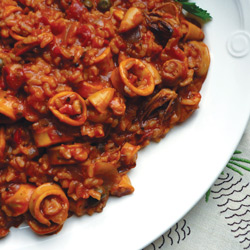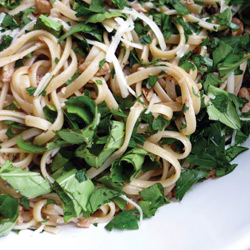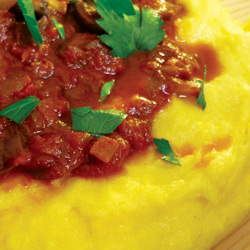Friends, family, food and festivities—these common factors are woven throughout generations and tie us together. They’re what make any holiday celebration, in any country, at any time of year, something we all inherently long for in our hearts. And this is never truer than when we glimpse inside an Italian-American household during the holidays and see grandchildren and even great-grandchildren learning about their roots, one tasty bite at a time.
Their stories are ones of struggle and success. It’s hard just moving across town—let alone moving across the world. But it’s that taste of home that brings everyone together.
“My father, Gasper Ghelardini, came to the States with $10 in his pocket when he was 16 years old. When Mom and Dad were alive, we always got together during the holidays for a big meal,” shared Bruna Facker, whose son and grandson serve on the Italian-American Society’s executive committee.
She remembers meals with polenta poured out onto a board in the middle of the table and topped with the rich, red gravy her mom had simmering all day. Her father would soak chestnuts in wine and roast them for New Years Eve. And of course, there were sweets. “Rosy, my mom, would pick cherries during the summer and put them in a large crock with lots of liqueur,” added Facker. “Then, we’d have them for a special treat during the holidays.”
Making something special out of what is available is a hallmark of regional Italian cuisine—a trait that carries over into their American culture today. Rudy Litwin, who was raised in a Polish-Italian community near Beallsville, Ohio, remembers his family foraging for wild mushrooms and hunting for rabbit on the family farm for their holiday meal.
“My dad was Polish, and my mom was Italian,” said Litwin. “On our farm, we also harvested berries and canned fruits, but everything had to be done by hand because there was no electricity or running water. It’s those simple things that made the holidays special.”
On Christmas Eve, his mother, like a lot of Italian mothers, fixed simple fried smelts and a variety of seafood dishes, including a humble squid with rice. “Us kids, we always fought over the squid roe—it was a special treat,” he recalled.
Litwin’s parents stayed up all night to decorate the tree and fill the stockings with apples, oranges and nuts. The family baked nut- and jam-filled cookies, homemade bread and pies.
“You always hung the longest sock you could get a hold of, and in the morning it was full of fruit and nuts. Looking back, it was the food and treats that were the real gifts. I still love making all of this stuff every year,” he adds.
The Italian-American Society of Peoria was founded in 1929 to provide assistance to Italian immigrants in the area, including help with language, housing, wages, illness and legal matters. Over the years, the organization has grown, and today they strive to preserve their ethnic culture and build a sense of community for Italian-Americans throughout central Illinois. (italianamericansociety.com)
Preserving this culture is why Marie Taraska studied Italian in high school and college and formed a local club to teach and study the language. From the Naples region of Italy, Taraska’s family, the Malimisuras (meaning “bad measure”), settled in South Philadelphia.
“My grandparents were the first generation to move here. But my grandparents did not want their children, my parents, to speak Italian. They wanted them to speak English because they were in a new country, and they should be more like Americans,” Taraska said.
Taraska remembers her grandmother taking her shopping in the open air markets of Philadelphia’s “Italian ghetto” where they would shop for fresh fruit, vegetables, chicken and Locatelli cheese—which is still one of her favorites today. During the holidays, her family enjoyed wine made by her grandfather, chestnuts roasted in an old iron skillet, and many traditional dishes, including baccala, smelts, linguine with walnut sauce and panettone for dessert.
To preserve her family’s food traditions and heritage, Taraska put her grandmothers’ and mother’s recipes into a cookbook for the family’s grandchildren.
“My five children are all over the country—but they come back home for Christmas Eve. We celebrate with what many would consider basic, peasant dishes—lots of sauce, fish, cheese and basil—but it’s the family being together that makes the meal special,” Taraska adds.
And that’s what the taste of home is all about. a&s
Gina Edwards is a cooking instructor and editor of andshecookstoo.com.
Continue reading for delicious Italian holiday recipes and more…
At Christmastime, many of the traditional Italian specialty sweets, including pizzelle and panettone bread, are available for sale at bakeries. Pizzelle are waffle-type cookies made from flour, eggs, sugar, butter or oil, and flavored with lemon or anise. These cookies from the Abruzzo region of Italy are on record as one of the oldest types of cookies, as they are believed to have been first made by the ancient Romans.
Panettone is an Italian sweet bread enjoyed during the holiday season. Time-consuming to make, most panettone is purchased, sliced and served with hot drinks or sweet wines at the end of the meal. While not similar in texture to fruitcake, panettone does contain candied citrus zests and raisins.
Recipes for lemon pizzelle and panettone bread pudding can be found at andshecookstoo.com.
 Calamari con Risotto (Squid with Rice)
Calamari con Risotto (Squid with Rice)
This one-pot dish is rich, creamy and perfect for feeding a large group of family on Christmas Eve. After a long simmer in tomato sauce seasoned with capers, crushed red pepper and oregano, the squid are tender and a perfect match for the velvety rice.
2 lbs. of squid, cleaned—tubes cut into rings and tentacles
1 tbs. olive oil
1 medium yellow onion, finely chopped
3 cloves of garlic, minced
28 oz. can crushed tomatoes
1 ½ cups water
1 tbs. capers
1 tsp. dried oregano
½ tsp. crushed red pepper flakes
Salt and pepper to taste
1 cup medium or short grained rice
Prep squid, set aside. Heat olive oil and sauté onion and garlic in a deep sauce pan until softened. Add crushed tomatoes and seasoning. Stir in rice and squid—bring to a boil, reduce heat, cover and simmer for 30 minutes. Serves six.
 Linguine con la Salsa Della Noce (Linguine with Walnut Sauce)
Linguine con la Salsa Della Noce (Linguine with Walnut Sauce)
Perfect for a cold winter night, this recipe is adapted from a family favorite of Marie Taraska’s. When her five children are home for Christmas Eve, this dish is always on the table, as it has been passed down through the generations. Marie still buys her grandmother’s favorite brand of Romano cheese from a small store in South Philadelphia.
3 tbs. olive oil
4-5 cloves garlic, minced
1 cup walnuts, finely chopped
1 cup of water or white wine
Salt and pepper to taste
16 oz. linguine, cooked al dente
¼ cup chopped flat-leaf Italian parsley
¼ cup chopped fresh basil
½ cup grated pecorino Romano cheese
Bring water to a boil, season with salt and boil the linguine until al dente (about 8-10 minutes). Meanwhile, sauté the garlic and walnuts in the olive oil until toasty brown in a large sauté pan; season with salt and pepper. Deglaze the pan with the water/wine and rapidly simmer to reduce the liquid (and concentrate the flavors) while the pasta cooks. Drain and toss the pasta with the walnut sauce and finish by tossing with the herbs and cheese. Serves six.
 Polenta con la Salsa di Pomodori (Polenta with Red Sauce)
Polenta con la Salsa di Pomodori (Polenta with Red Sauce)
A large board in the center of your table spread with warm, creamy polenta and topped with a rich red sauce is a common fixture on Christmas Eve tables in Italian-American homes. The dish is extremely versatile—Rudy Litwin’s family made their sauce with wild mushrooms or rabbit they caught on their farm, and Bruna Facker remembers her family made it with well-seasoned Italian sausage. This recipe includes eel—as part of the Feast of Seven Fishes—but no matter what you use, the finished dish offers comforting warmth and a dramatic presentation.
For the polenta:
6 cups water
3 cups yellow cornmeal
Salt
To finish—butter and parmesan cheese
For the eel and mushroom red sauce:
2-3 tbs. olive oil
1 medium yellow onion, finely chopped
1 clove garlic, minced
2-3 sprigs of fresh flat-leaf Italian parsley
Salt and pepper to taste
½ lb. crimini mushrooms (baby bellas)
2-3 tbs. tomato paste
1 cup red wine
2 lbs. eel, cleaned/de-boned, skinned and cut into one-inch chunks
28 oz. can crushed tomatoes
Fresh, chopped flat-leaf Italian parsley to serve
Prep eel and set aside. Put the water on medium-high heat in a deep sauce pot, cover and bring to boil. Meanwhile, heat the olive oil over medium heat in a large sauté pan and sauté the onion, garlic and parsley until softened. Add the mushrooms and sauté until brown. Stir in the tomato paste and deglaze the pan with the red wine. Add the tomatoes and eel and simmer on low heat (uncovered) for 30 minutes.


